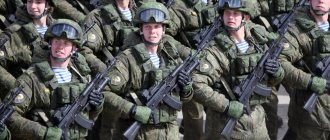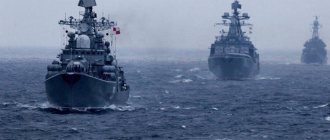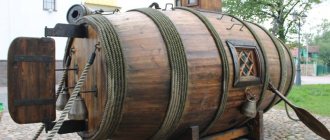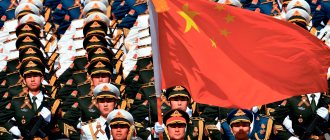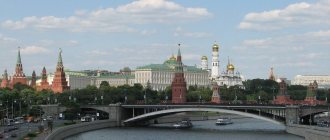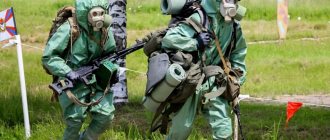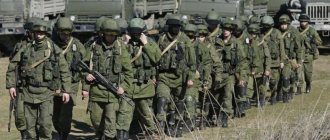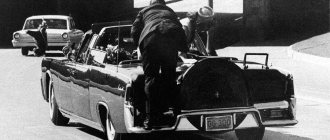History of special forces
Special forces were created in the 50s by secret order, subordinate to the Main Intelligence Directorate of the General Staff.
The first Soviet special forces could eliminate commanders and influential political figures of the aggressor countries, destroy missile launcher complexes, aircraft control centers or communication channels with nuclear submarines. Carrying out their assigned tasks, the special forces had to skillfully bring the enemy into panic.
At the beginning of the 80s, there were 11 special forces brigades in the country. They fought in Afghanistan, Chechnya - their numbers grew. Special forces troops ceased to be a “piece” commodity; fighters were used more and more often.
Special Operations Forces in the Russian Federation: formation
MTR are troops created to defend and protect the interests of Russia and its citizens anywhere in the world. These are special forces that perform tasks in peacetime.
The history of the formation of the MTR of the Russian Armed Forces begins with the founding of special-purpose military units, on the basis of which, on March 5, 1999, the Specialist Training Center appeared. Part is located in Solnechnogorsk. The GRU group was subordinate. Then it was called the Senezh Special Purpose Center. The soldiers who underwent special training in the unit were nicknamed “sunflowers.”
The new military unit took its first battles in Chechnya, during the second Chechen campaign.
Almost ten years later, during the period of reform of the RF Armed Forces, the special unit was reorganized into the Special Operations Directorate, reporting to the Chief of the General Staff of the RF Armed Forces.
In April 2011, with the assistance of the FSB special forces, the formation of another Special Operations Center began. The TsSN is subordinate to the head of the GRU and is located near Moscow. The unit was called the Kubinka-2 Special Purpose Center.
In March 2013, Russia announced that the country was training special operations forces. "Senezh" and "Kubinka-2" are part of the new forces.
Three years later, the naval special operations department of the MTR was included in the Navy in Crimea.
The first commander of the Special Forces of the Russian Armed Forces - Oleg Martyanov, 2009-2013. The Special Operations Forces Command remains one of the most closed structures of the Russian Armed Forces.
Independence
The status of a unified combat command, and even the only one approved by a legislative act of Congress, makes the American SOF actually another independent branch of the military. In some matters no less influential than, for example, the US Marine Corps. This allows the SOF to conduct its own operations in some cases. At such moments, they are subordinate to the assigned linear units and subunits, designed to support the actions of the “specialists.”
(Photo: Russian Ministry of Defense)
In Russia, special operations are still more of a supporting means, the task of which is to create conditions for successful operations of linear units and formations of the ground forces, air force and navy. Special operations, as a rule, are small in scale and aimed at solving local problems of reconnaissance and sabotage nature. Recently, however, the situation has begun to change towards increasing independence of the SOF and their operations.
Rating:
USA - 5 Russia - 4
Day of "Polite People"
The President signed the decree establishing the Day of Special Operations Forces on February 26, 2015; the next day, the soldiers celebrated their first “day of polite people” - February 27.
A year before the signing of the decree, on the night of February 27, Russian soldiers occupied all objects of importance in ensuring the defense capability of Crimea and parts of the Ukrainian Armed Forces. Locals nicknamed the people in camouflage “polite” because they, performing a special task at a busy time, behaved extremely courteously and modestly with Crimeans.
The emblem of the special operations forces is a bow with a stele on a string pointing upward. On the plumage of the arrow there are two spread wings.
Equipment of MTR fighters
The equipment and weapons of special operations forces are unique. The equipment includes:
- headphones that muffle the sounds of combat and make it possible to talk through the built-in radio station (removed);
- a Kalashnikov assault rifle of the latest model with Picatinny rails on which additional equipment can be mounted;
- collimator sight;
- silent firing devices;
- anti-fragmentation glasses;
- helmet – shockproof and anti-fragmentation;
- gun;
- mount for night vision device;
- body armor - capable of stopping a bullet fired from a machine gun and a sniper rifle, with mounts for magazines with cartridges, grenades and a first aid kit;
- optical sight;
- camouflage with built-in elbow and knee pads;
- Lightweight and durable tactical boots.
The equipment also includes: a tactical protection kit, an anti-fragmentation suit, a wetsuit, a diving kit, an unloading vest, and a thermal imaging monoculator.
The most unclassified thing is medical equipment.
Each specialist has:
- Standard wearable medical kit.
- Portable stretcher for carrying the wounded from the battlefield.
- Means to stop bleeding - bandages, tourniquet or tourniquet, systems, saline solution, hemostatic agent.
- Anti-poisoning agents, antiseptics, painkillers, antishocks, hemostatic agents.
The set weighs about 10 kg.
How Special Operations Forces soldiers work
The occupation of MTR fighters is conducting reconnaissance and sabotage behind enemy lines, as well as maintaining order in their rear.
The work comes with many hardships. Military service is at the limit, tickling your nerves, requiring every effort and willingness to sacrifice yourself for the sake of others.
The most important factor is the combat coherence of the team. What is needed here is absolute discipline, unconditional following of the commander, and at the same time the ability to make independent decisions individually by each fighter.
Physical training is a necessary factor in specialist training. Daily activities become a way of life. A warrior must have an absolute reaction in any situation, have the utmost restraint and endurance.
Equally important is the ability to work with modern types of weapons. This requires constant improvement of the professionalism of each specialist.
Working in a team, two or three, as part of a group is based on ideal interaction, the ability to literally understand comrades in arms without words. Through training, every movement becomes automatic. Each warrior must not only know his maneuver, but also be able to act instinctively and predict the actions of the enemy.
Result:
USA - 24 Russia - 19.5
The undeniable advantage of the United States? Well, depending on how you look at it. The position of “gendarme of the planet” forces the United States to be equally strong in many places at once. This is exactly the case when power often turns out to be the other side, turning out to be insufficient. The Russian SOF in its current form has shortcomings, mainly related to the transition to a new structure and the absence of a number of important elements, but they are fixable. But no one will lift the burden of global presence from the Americans.
"Military surgery"
The special operations forces of the Russian Federation are the military elite. The army group uses modern types of weapons and equipment, is well equipped and is ready at any time to carry out a combat mission in any conditions, anywhere on the planet. The fighters are faced with the task of protecting the interests of Russia and its citizens. Their job every day is to be ready every minute to immediately use their skills.
These are special forces, they use combat methods that other troops do not use. MTR fighters are reconnaissance saboteurs, demolitionists, counter-saboteurs and partisans. They are paratroopers and divers, and use both small arms and anti-ship missiles.
Structure
It is difficult to compare in detail. Information about the structure of the Russian KSSO is closed. However, some things can be compared. The advantage of the American structure is its comprehensiveness, with the inclusion of special forces of all types of armed forces. In a similar Russian system there is no special forces of the aerospace forces, which are absent in principle. Tasks in the interests of the Aerospace Forces, as a rule, are carried out by special forces units of the Main Directorate of the General Staff, which does not always contribute to optimal interaction with aviation units.
In addition, the Russian MTR, unfortunately, does not have important interspecific communications units. Such as the American Joint Communication Unit. It is necessary to build interaction anew in each individual operation.
Rating:
USA - 5 Russia - 3.5
MTR in Syria
Precise airstrikes were carried out thanks to the professionalism of the fighters. Specialists work deep in the rear, using the entire arsenal of special reconnaissance and enemy detection equipment. And snipers with rifles do no less than bombers.
Adjusting airstrikes, eliminating terrorists and destroying important objects - these are the tasks facing the MTR.
Russian armed forces were invited by the Syrian authorities. It was decided that it was better to stop the terrorists there than to wait for them in Russia. The MTR units found themselves in the thick of the confrontation. The skills acquired during training are used in combat conditions, skills are honed and professionalism increases.
Brief background
As is known, the Special Operations Forces of the Russian Armed Forces were officially created by Decree of the President of the Russian Federation No. 103 dated February 26, 2015, which means, according to Chinese analysts, the head of the Russian state officially recognized the importance of these units in situations such as armed conflicts in Ukraine and Syria.
Marshal of the USSR G.K. Zhukov
Chinese experts are quite familiar with the history of the emergence of special forces units (SPU), which were formed by the decision of Marshal of the USSR G.K. Zhukova. The legendary commander realized that the state and military leadership needed special intelligence units capable of:
- overcome protected state borders with high secrecy;
- carry out tasks to search for, eliminate or capture enemy commanders;
- deep behind enemy lines, disrupt the operation of supply systems with weapons and equipment.
Chinese analysts consider the main and most important difference between the special forces of the Soviet period to be serious linguistic training, which allowed Soviet officers to operate effectively throughout the Afghan campaign. According to Chinese sources, over 10 years of armed conflict, the Special Forces units of the USSR Armed Forces lost 191 people killed. At the same time, they captured from the Mujahideen samples of weapons and equipment in quantities designed to fill a motorized rifle division. It is obvious that the approach followed by the Command of the USSR Armed Forces - recruiting officers and personnel from among ethnic Uzbeks and Tajiks who served in the Turkestan Military District into Special Forces units - fully justified itself.
GRU Special Forces unit in Afghanistan, disguised as militants
The saddest stage in the history of Soviet/Russian special forces was the beginning of the 90s, when formation commanders simplified combat training tasks for special forces units to conducting operational-tactical reconnaissance in the interests of formation and formation commands. As a result of this, several units actually performed the same task, which negatively affected the level of information to the command and the quality of decisions made.
Some commanders of Special Forces units in military districts tried to borrow Western techniques when training personnel and developing new conceptual solutions. However, the Armed Forces did not have the financial resources to fully study these issues, and the military leaders of that period did not have the decisiveness.
Unique tasks of the MTR
Modern intelligence, surveillance and communications tools require extensive knowledge in the field of computer technology. Simulators using the latest electronics allow specialists to hone their skills and improve their professionalism in conditions that are as close as possible to combat.
Carrying out combat missions in different regions requires knowledge of the language of the host country, culture and folk customs.
Being in contact with the local population is an important factor in obtaining and implementing the obtained information. Great attention is paid to undercover operational and tactical-special training. Specialists must perfectly know the basics of tactics and strategy of modern warfare.
They work under the heading "secret"
The Russian Ministry of Defense's special forces use combat training systems. An important place is given to parachuting, fire training, mine demolition and sapper work, and tactics.
SOF influence the economy and politics of other states with muscle and strength, but secretly. They train foreign partisans, destroy important objects, and eliminate those who are in the way. There are MTRs in the USA, Germany, England, France, and Israel. And they don’t sit anywhere without work.
There have been people in our country who have performed critical tasks all over the world, and they continue to do their work today.
All Russian special forces troops are fighting in the Caucasus with varying intensity, participating in special operations to destroy bandits and extremists.
Today, the Russian Armed Forces have 7 special forces brigades, as well as 4 squads of combat swimmers.
Technical equipment
The higher status of USSOCOM provides the American SOF with better access to numerous material benefits - no one else has such a number of special modifications of helicopters, airplanes, and ground vehicles optimized specifically for special forces missions. In Russia, of course, there are aviation units that specialize in supporting special operations, but their materiel is, as a rule, standard serial multi-purpose helicopters and transport aircraft, perhaps with a little more rich equipment.
Available personal equipment and weapons are also more varied in the United States. In Russia, special forces often purchase imported equipment, machinery and weapons - there are no domestic analogues.
Rating:
USA - 5 Russia - 3
An MTR detachment is worth an entire army
Only the best of the best make it into the MTR. Candidates undergo a rigorous selection process. The results of severe tests determine whether a person is able to withstand difficult situations and not give up in the face of the most dangerous tasks.
Daily training is necessary to be ready to carry out any combat mission as clearly and effectively, promptly and creatively as possible. Today, special operations forces of the Russian Federation carry out direct work in the hottest spots of the planet.
Possibility of penetration
On the one hand, the United States has all the trump cards - the widest network of bases and military facilities, coupled with non-military structures that are ready to “hide” “specialists” under their roof, gives them significant advantages and allows them not to waste time preparing for entry. Sometimes this leads to failures - due to an incorrect assessment of the conditions in which one must act. On the other hand, the shortage of such funds and infrastructure in Russia forces us to better prepare and legend operations, to act as effectively as without leaving a trace, even in a hostile environment.
Rating:
USA - 4 Russia - 4
The country's military elite
The first special forces appeared in the GRU of the General Staff of the Russian Federation. Later, in other law enforcement agencies and intelligence services, special units were formed, designed for various tasks. For example, TsSN FSB "Alpha" fights terrorism in transport, "Vympel" - at particularly important facilities.
There are special forces in the Ministry of Internal Affairs and in the internal troops. The famous “speckled berets” resist gangs and provide forceful support to the police. The task of the FS OBNON special forces is to fight the drug mafia. Special forces of the Federal Penitentiary Service countering riots in the penitentiary system - in Russian prisons and zones.
In the West, all special operations forces are brought into a single fist: land, sea, and air. In the Russian Federation everything is fragmented. For several decades, the command has been trying to include aviation squadrons in the brigades, but so far to no avail.
But the leadership of the Russian armed forces has ceased to be shy about what they are doing in other countries. It declared its interests around the world and its goals to save and protect all Russian citizens: diplomats captured by extremists, sailors captured by pirates, Russian citizens held hostage.
At the foot of Elbrus there is a stela dedicated to the Heroes of the Defense of Elbrus. Here, a Russian soldier defeated a division of selected German climbers in the war.
Russia is returning to great history. It is argued that where the Russian soldier came, there will be peace, tranquility and justice. At the same time, we are talking not only about the special operations forces of the Russian Federation.
